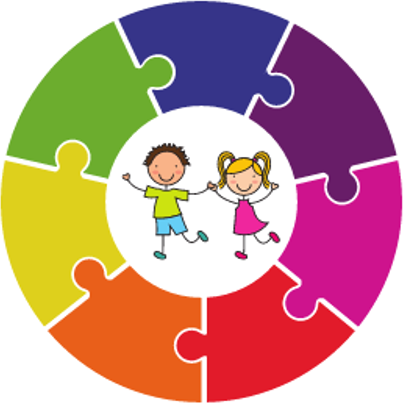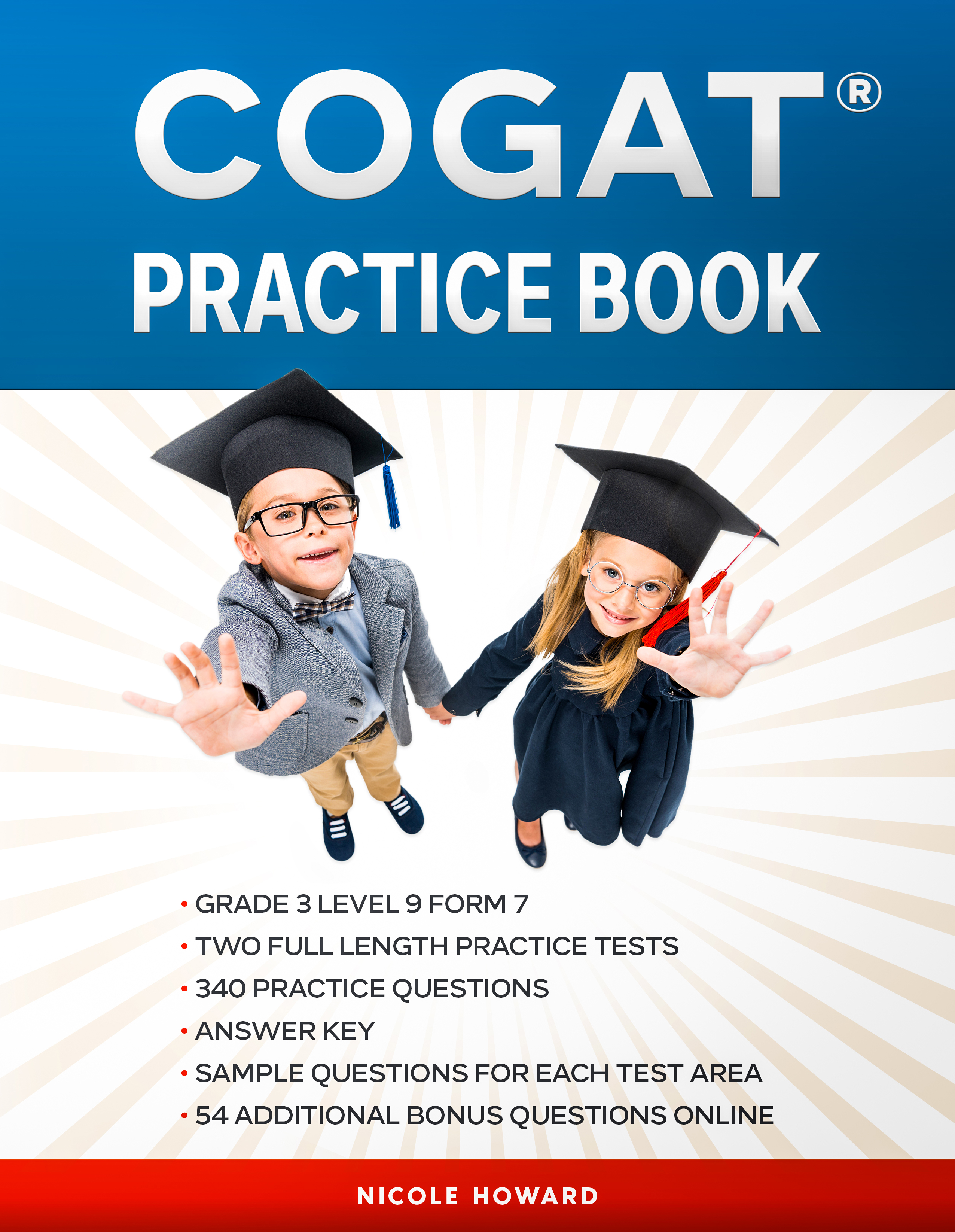
Cogat® Test (Cognitive abilities test)

A number of gifted and talented schools in the United States can require students to take CogAT® test to be eligible for enrollment.
The Cognitive
Abilities Test (CogAT®) is a set of ability tests that are used in
combination to evaluate students' ability to reason and solve problems
using verbal, quantitative and spatial symbols.
CogAT® is provided to K-12 students and the test levels are categorised by age group.
There are 3 different levels in which your child is assessed on CogAT®:
verbal
quantitative
non-verbal.
These skills are not actually tested in schools, or at least the way they are evaluated on CogAT is not the way they are tested in schools. For this reason, you should help your child by training him with practical CogAT® questions.
The verbal battery tests the student's vocabulary, as well as his comprehension of concepts, performance and oral retention, and the skill of identifying the correlations between words. Studies indicate a strong relationship between high verbal ability and successful performance in a wide range of school topics. Each sub-test has approximately 20 questions and the candidate has ten minutes to finish each one.
The quantitative battery checks the student's quantitative thinking and its ability to solve problems and offers an evaluation of the candidate's basic degree of abstract reasoning.
The non-verbal battery only features geometric patterns and
figures that have little direct relevance in formal school teaching.
The tests do not require reading. The non-verbal battery is especially
appropriate for gaining an accurate evaluation of performance for
students who have problems with reading, or have limited knowledge of
English.
Each part of the CogAT®Test is divided into subsections.
For example, the verbal section of level 9 of CogAT® has three subtypes of questions that need to be answered:
1) Sentence completion: Students are required to select the words that accurately complete the sentences in this section. This tests their knowledge of vocabulary.
2) Verbal classification: Students are required to classify words in similar groups in this section. They will be given three words that have something in common, and asked to identify a fourth word that completes the set.
3) Verbal Analogies: Students are asked to identify the analogies and will be asked to look for two words that make a readable pair in the test phrases.
The non-verbal section includes three subtypes of questions that need to be answered:
1)Figure classification: Students are required to analyze three similar figures and apply the next appropriate figure to complete the sequence in this section.
2)Figure Matrices: Students are introduced to the basic matrices (2x2 grids) to solve the missing shapes within them.
3) Paper folding : Students are introduced to paper folding and will need to ascertain where the holes punched in a piece of folded paper are after the paper has been unfolded.
The quantitative section is divided into three subsections:
1) Number Series: Students are required to determine which number is needed to complete a series that follows a specific pattern.
2) Number puzzles: Students will have to solve numerical puzzles and simple equations.
3) Number Analogies: Students will be introduced to numerical analogies and will be asked to determine which numbers are missing from number sets.
How many questions will your child need to answer in the CogAT Test?
The number of questions on CogAT® Form 7 depends on the degree of the CogAT® test. Students usually have 30-45 minutes per battery. In total, CogAT® has between 118 and 176 questions, depending on the grade.
COGAT KINDERGARTEN, LEVEL 5/6: The total time given for the three sections of the Level 5/6 test is 112 minutes.
Verbal Section
● “Sentence completion” has 14 questions.
● “Picture classification” has 14 questions.
● “Picture analogies” has 14 questions.
Nonverbal Section
● “Figure matrices” has 14 questions.
● “Paper folding skills” has 10 questions.
● “Figure classifications” has 14 questions.
Quantitative Section
● “Understanding number analogies” has 14 questions.
● “The number series” has 14 questions.
● “Solving number puzzles” has 10 questions.
The total number of questions is 118.
COGAT GRADE 1 LEVEL 7: The total time given for the three sections of the Level 7 test is 112 minutes.
Verbal Section
● “Sentence completion” has 16 questions.
● “Picture classification” has 16 questions.
● “Picture analogies” has 16 questions.
Nonverbal Section
● “Figure matrices” has 16 questions.
● “Paper folding skills” has 12 questions.
● “Figure classifications” has 16 questions.
Quantitative Section
● “Understanding number analogies” has 16 questions.
● “The number series” has 16 questions.
● “Solving number puzzles” has 12 questions.
The total number of questions for these three sections equals 136.
COGAT GRADE 2 LEVEL 8: The total time given for the three sections of the Level 8 test is 122 minutes.
Verbal Section
● “Sentence completion” has 18 questions.
● “Picture classification” has 18 questions.
● “Picture analogies” has 18 questions.
Nonverbal Section
● “Figure matrices” has 18 questions.
● “Paper folding skills” has 14 questions.
● “Figure classifications” has 18 questions.
Quantitative Section
● “Understanding number analogies” has 18 questions.
● “The number series” has 18 questions.
● “Solving number puzzles” has 14 questions.
The total number of questions for these three sections equals 154.
COGAT GRADE 3 LEVEL 9: The total time given for the three sections of the Level 9 test is an hour and a half (30 minutes per section).
Verbal Section
● “Sentence completion” has 20 questions.
● “Verbal classification” has 20 questions.
● “Verbal analogies” has 22 questions.
Nonverbal Section
● “Figure matrices” has 20 questions.
● “Paper folding skills” has 16 questions.
● “Figure classifications” has 20 questions.
Quantitative Section
● “Understanding number analogies” has 18 questions.
● “The number series” has 18 questions.
● “Solving number puzzles” has 16 questions.
The total number of questions for these three sections equals 170.
COGAT GRADE 4 LEVEL 10: The total time given for the three sections of the Level 10 test is 90 minutes (30 minutes for each section).
Verbal Section
● “Sentence completion” has 20 questions.
● “Verbal classification” has 20 questions.
● “Verbal analogies” has 24 questions.
Nonverbal Section
● “Figure matrices” has 22 questions.
● “Paper folding skills” has 16 questions.
● “Figure classifications” has 22 questions.
Quantitative Section
● “Understanding number analogies” has 18 questions.
● “The number series” has 18 questions.
● “Solving number puzzles” has 16 questions.
The total number of questions for these three sections equals 176.
COGAT GRADE 5 LEVEL 11: The total time given for the three sections of the Level 11 test is 90 minutes (30 minutes for each section).
Verbal Section
● “Sentence completion” has 20 questions.
● “Verbal classification” has 20 questions.
● “Verbal analogies” has 24 questions.
Nonverbal Section
● “Figure matrices” has 22 questions.
● “Paper folding skills” has 16 questions.
● “Figure classifications” has 22 questions.
Quantitative Section
● “Understanding number analogies” has 18 questions.
● “The number series” has 18 questions.
● “Solving number puzzles” has 16 questions.
The total number of questions for these three sections equals 176.
COGAT GRADE 6, LEVEL 12: The total time given for the three sections of the Level 12 test is 90 minutes (30 minutes for each section).
Verbal Section
● “Sentence completion” has 20 questions.
● “Verbal classification” has 20 questions.
● “Verbal analogies” has 24 questions.
Nonverbal Section
● “Figure matrices” has 22 questions.
● “Paper folding skills” has 16 questions.
● “Figure classifications” has 22 questions.
Quantitative Section
● “Understanding number analogies” has 18 questions.
● “The number series” has 18 questions.
● “Solving number puzzles” has 16 questions.
The total number of questions for these three sections equals 176.
COGAT GRADE 7/8, LEVEL 13/14: The total time given for the three sections of the Level 13/14 test is 90 minutes (30 minutes for each section).
Verbal Section
● “Sentence completion” has 20 questions.
● “Verbal classification” has 20 questions.
● “Verbal analogies” has 24 questions.
Nonverbal Section
● “Figure matrices” has 22 questions.
● “Paper folding skills” has 16 questions.
● “Figure classifications” has 22 questions.
Quantitative Section
● “Understanding number analogies” has 18 questions.
● “The number series” has 18 questions.
● “Solving number puzzles” has 16 questions.
The total number of questions for these three sections equals 176.
How can you Successfully Train your Child for the CogAT test?
CogAT® is a test specifically developed to assess natural attitudes or skills. However, these skills can be greatly enhanced if the child is properly stimulated from an early age, simply feeding his desire to learn, through the development of thinking and reasoning skills.The ability to observe, understand, develop emotional reactions, speak, and coordinate motor and mental skills depends on how and when the child's environment interacts effectively with his genetic background.
The key is to follow a fun and stimulating training every day, without boring your child but offering him challenging games and fun learning books. You also need plenty of exercises that are appropriate for your child's age. You can find my collection of books Here. Once you purchase one of my books, you will be able to get a free download of other useful exercises.
Try to proceed gradually, without ever asking your child what he is not yet able to give, with patience and serenity.
And remember: your child must enjoy learning and have fun!

CogAT® PRACTICE BOOK GRADE 3
Grade 6 Level 12 Form 7
One Full Length Practice Test
176 Practice Questions
Answer Key
Sample Questions for Each Test Area
54 Additional Questions Online
Cognitive Abilities Test™ (CogAT®) is a registered trademark of Riverside Assessments, LLC and its affiliates (“Riverside”), which is not affiliated with Gifted Child. The tests mentioned on this site are trademarks and/or registered trademarks of their respective publishers, affiliates or licensors. SkilledChildren.com is not affiliated or related to the above mentioned publishers or their affiliates (the "Publishers"). The Publishers do not sponsor or endorse any SkilledChildren.com product, nor have SkilledChildren.com products or services been reviewed, certified or approved by the Publishers. Trademarks referring to specific test providers are used by SkilledChildren.com for nominative purposes only and such trademarks are the exclusive property of their respective owners.